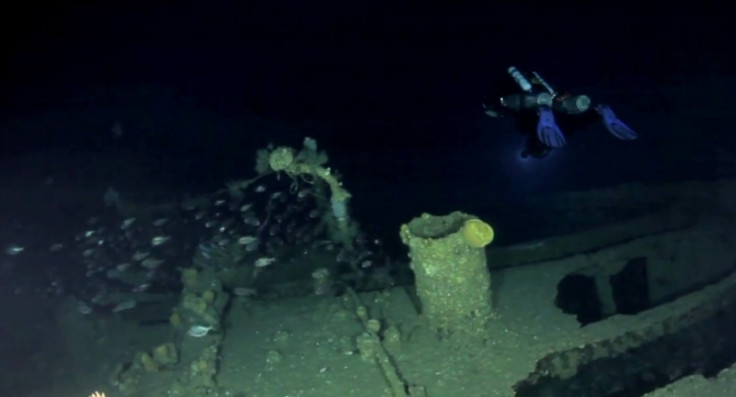SS Ventnor: 112-Year-Old Shipwreck Carrying 499 Chinese Miner Bodies Found in New Zealand

A long-lost shipwreck that set out from Wellington, New Zealand 112 years ago to deliver the remains of 499 Chinese miners who died during the gold rush has finally been found.
The Glasgow-built cargo ship SS Ventnor was bound for Hong Kong in 1902 to deliver coffins with the remains of Chinese immigrants back to their hometowns in China when it sank near Whangarei, off the northern coast of New Zealand.
The search for the shipwreck, which has so far cost NZ$300,000 (£149,433), is the subject of a new documentary series entitled The Lost Voyage of 499. Its first episode has just aired on Maori Television in New Zealand on Monday (24 November).
The ship was carrying a full crew as well as between six to nine elderly Chinese men who were granted free passage to Hong Kong in exchange for looking after the coffins.
The day after leaving Wellington, the ship struck rocks near the coast of Taranaki, however the captain decided to press on to the nearby port of New Plymouth to repair the damage.
Unfortunately, the ship took on water and sank off the Hokianga Heads on 28 October 1902. Of the four lifeboats that launched from the ship with the crew and passengers aboard, three made it to safety, but the last lifeboat, which held the captain, sank with 13 fatalities.
Maori tribes buried any body parts that floated to the surface of the ocean at special burial sites, but the rest of the bodies have remained entombed in the shipwreck.
19<sup>th century Chinese immigrants
In 1864, the Otago Provincial Council invited Chinese immigrants to come to New Zealand and work in the South Island gold mines as European miners left the area to find new gold fields.
Although the work was strenuous, many people wanted to leave Guangdong in China due to the suppressed Taiping Rebellion, and within five years there were more than 2,000 Chinese men working in New Zealand.
The Chinese miners founded Cheong Sing Tong, a subscription association where they could pool their resources and decided to send all Chinese immigrants who had died back to China so that their relatives could give them proper burial rites following Chinese cultural traditions.
The leader of Cheong Sing Tong was a successful Chinese businessman named Choie Sew Hoy who sold supplies to the Chinese miners, and he oversaw a successful repatriation of 230 bodies in 1883.
The bodies, some of which had been buried for 20 years, were exhumed from cemeteries in Otago, and intact bodies were sealed in zinc caskets, while bones were scrubbed, dried, tied inside calico bags and then placed in small wooden coffins.
Unfortunately Choie died suddenly before the SS Ventnor set sail, and his body was added to the cargo.
As the ship's manifest was lost with the ship, there is no way of knowing which miners' remains were on the ship apart from Choie, and many families in China and New Zealand still want closure.
Discovering the SS Ventnor
In December 2012, the shipwreck was spotted using sonar by the Ventnor Project Group, a team of investigators funded by independent filmmaker John Albert of Definitive Productions, who was making a documentary about the shipwreck seen from the eyes of Choie's living descendants.
However, the authenticity of the find has not been revealed until this year and according to Stuff.nz, efforts were made to keep the project quiet from Heritage New Zealand.
The shipwreck site has now been classed as an archaeological site, so no further work can be undertaken to modify, remove items or destroy the site unless authorised by officials.
In 2013, the Ventnor Project Group began discussing its findings with Dr Jian Yang, a National MP representing New Zealand's Chinese community in parliament, as well as Chinese officials from Guangdong.

The group also made two further dives in January and April 2014, filming the shipwreck and recovering some artefacts from it, including a small bell, a lamp, a porthole and an engine order telegraph.
According to AP, there is now controversy over the shipwreck as Choie's descendants claim that Albert only asked their permission to send a remote-controlled underwater robot, but not to take artefacts.
The New Zealand Chinese Association feels that the bodies of the dead should be left alone in the shipwreck, rather than exhuming and trying to identify old remains.
Kirsten Wong from the association told the New Zealand Herald: "[There is] genuine dismay felt across the NZ Chinese early settler community for the lack of respect being shown towards their ancestral remains and the disregard for the communities - Chinese and Maori - whose story it is.
"The community is also distressed about suggestions that historic artefacts be shipped to China, when they say the artefacts are not only significant for them, but are an important part of all New Zealanders' social and cultural heritage."
© Copyright IBTimes 2024. All rights reserved.






